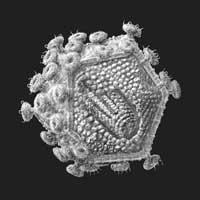Text written in Basque and translated automatically by
Elia without any subsequent editing.
SEE ORIGINAL
Pigmentary retinosis looking through the tunnel
2009/02/01
Kortabarria Olabarria, Beñardo - Elhuyar Zientzia
Iturria:
Elhuyar aldizkaria
Dogs help the blind. It is a known story, but there are new versions. In one of them, an American veterinarian of Cuban and Basque origin returned the ability to see a blind dog. To obtain the miracle, the researcher used the research work of years, of his collaborators and of the gene therapy. His work was so great that other researchers began to experiment with similar humans. The results were not as good as with dogs, but they were encouraging...
Pigmentary retinosis looking through the tunnel
01/02/2009 | Kortabarria Olabarria, Beñardo | Elhuyar Zientzia Komunikazioa

(Photo: sandia.gov)
One of the dogs, the first who was intervened, was called a gentleman: Lancelot. Pigmentary retinosis disease left her blind until 7 years ago gene therapy helped her to regain her sight. Since then, in his exams and tests highlights that Lancelot sees him as well as any other healthy dog. He recovered his vision at the University of Pennsylvania thanks to a treatment developed by Gustavo Aguirre's research team. Because both, in addition to recovering sight, first opened the way for other dogs and then the way for people.
The designation of retinosis pigmentaria includes a set of hereditary diseases that affect the eyes. They are degenerative diseases that cause the progressive loss of vision. Initially they affect external or peripheral vision and night vision: patients see it as if they look outside a tunnel. In some cases, the disease becomes blindness over time. It is considered a rare disease, since the number of people affected by each variant, with so many variants, is not very high.
The retinosis damage the retina; hence the name. The retina, besides covering the inside of the eye, takes the images that surround it, processes them and sends them to the brain through the optic nerve. In the retinosis pigmentarias some of the retina cells are gradually destroyed, especially photoreceptors, appearing accumulations of pigments inside the eye. As a result, the view is decreasing, spending.
In research
Studies carried out in molecular biology have revealed the existence of different types of pigmentary retinosis. According to recent studies, there are at least 190 genes related to this disease, and it would not be surprising that new genes were discovered. As if it were not enough, each of the genes can have a large number of mutations, many times more than a hundred. Consequently, most of those who present pigmentary retinosis have different mutations in different genes.
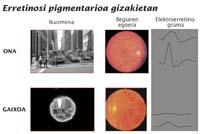
(Photo: www.sph.uth.tmc.edu/RetNet)
The complexity of the disease is evident. The variability of genes increases the complexity of treatments that could occur in the future. And there is a certainty among researchers that it increases the degree of complexity: many of the genes that cause retinosis pigmentosa also affect other diseases of the retina.
Since, for the time being, it is not possible to observe the broad genetic universe as a whole, researchers are selecting one area or another and looking into it. Among them is the Experimental Ophthalmology Group of the UPV, under the responsibility of Professor Elena Vecino. This team fights against degenerative diseases of the retina.
They collaborate with Gustavo Aguirre, a researcher who has given the sight to Lancelot and other dogs who have come after.
The UPV ophthalmology team has also worked with animals: They investigate dogs with the mutation of the protein RPE65. The RPE65 protein is found in the retinal epithelium, along with photoreceptors, and researchers know it is fundamental to be able to see it well. When failures occur in this protein, photoreceptors do not function, patients enter the dark tunnel and it is impossible to see them.
Elena Vecino's research team has shown that the alterations that occur in the canine and human retina are similar. Until now, the researchers knew that in the retinosis the organization of photoreceptors was altered and that they appeared there where they should not be. They discover that the same occurs in animals. Another of the conclusions of the studies was to know that the structure of the retina in general is maintained, that it is not destroyed and that the altered cells do not disappear. Damage yes, but not at all. This has made researchers think that there may be more than one way to perform a proper therapy.
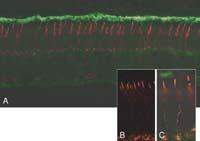
The protein RPE65 (in green) is found in the epithelium of the retina, together with the fotoreceptors (in red). In Figure A, a healthy retina; in Figure B, a retinosis and in Figure C, a retina treated with gene therapy.
(Photo: R. R. Neighbor)
During the last year, UPV researchers have been studying to what extent the damage produced in the retina can be repaired by gene therapy. In short, they have shown that the virus injection technique that causes the production of RPE65 can be a suitable treatment, since the retina is recovered, but only when this injection occurs under the retina. If done so, the animals regain sight and no side effect occurs in the eye.
In view of the excellent results of these and other animal research, there has already been a leap in research in gene therapy with humans. For the moment, the results of the trials have been encouraging, but only encouraging.
Other treatments Other treatments
Although the effect of gene therapy on retinosis is evident, it is not the only strategy being applied against this disease.
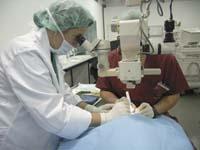
Elena Vecino is operated.
UPV/EHU
Among the drugs, for example, neutrophic factors are being used, that is, a set of natural proteins that help keep cells alive and healthy. In the trials that have been carried out in animals, results have been obtained, which have been taken into account, and are currently working on the development of continuous, slow release devices. Encapsulated cells would be an example of this. In this therapy, a small device is placed in the eye. The device carries CNTF proteins from the retina that are slowly released. If everything goes well, the death of photoreceptors is avoided and, therefore, the loss of vision. In this line of research, we are working to find more neutrophic factors, to understand how they affect retinal cells, to know if they can act on other diseases of the retina, and to study new techniques of integration in the eye of neutrophic factors.
Research on vitamin A in the field of food has gained a lot of strength, since in some studies have shown that with the daily intake of this vitamin the retinosis advances more slowly, but the information on the possible benefits of this treatment is minimal. The retinal cell transplants, the programming of stem cells, the surgery... are mentioned among the possibilities of curing the retinosis, but so far there is no adequate treatment for people with retinosis, let alone the way to cure the disease. Man is more complex than the dog, pigmentary retinosis, and the solution will be complex. But the end of the tunnel is underway.
Gustavo Agirre: 90% of treated dogs recover sight
American researcher Gustavo Aguirre visited San Sebastián from the hand of the Association of Retinosis Pigmentaria of Gipuzkoa. Veterinarian, has developed a pioneering treatment based on gene therapy to combat this disease. He has tried with dogs and with excellent results most have managed to recover the sight. Now others, with the same technique, work with human beings.
What technique has it used to combat canine retinosis?
We use the therapeutic treatment that we have jointly developed researchers from the United States. The same technique is nothing difficult. We inject the dog a virus under the retina. This virus produces the formation of a protein that is lost due to pigmentary retinosis.
Does this virus have no other effect?
In fact this virus contaminates 80% of human beings, but it is not capable of causing diseases. We previously manipulate the virus so that it does not fracture or reproduce. The virus infects cells, but since it cannot be divided, it stays in the cell itself and the cell produces the gene protein inserted with the virus.
Do you use another technique?
Yes, the technique of encapsulated cells. Encapsulated cells have been developed together with a group of an American company, Neurotech. The capsules are placed inside the eye and transmit a factor capable of protecting the cells found in the retina itself. In this way, the cells that remain in the retina survive so that they do not deteriorate.
So far you have researched especially with dogs. Why?
Many years ago we began to investigate with dogs, because human retinosis is very similar to that of dogs. At first we focused on trophic factors. Around the year 1998 we started working with encapsulated cells, with which we managed to make the disease partially paralyzed. With the treatment of gene therapy we started in 2001. Well, the truth is that in 2000 we started rehearsing with dogs, in July, but for the first time we published this data in 2001.

(Photo: B. B. Windbreak)
And what results have you obtained?
From 2001 to the present day we have carried out this treatment based on gene therapy to more than 50 dogs, ie virus injection. The 90% of the dogs have recovered sight. Technical and non-therapeutic problems in failed treatments. In these cases we have repeated the treatment and in general we have had very good results, they recover the sight.
You have also begun rehearsing with human beings.
Yes, they have also started with humans, and I say it because I have not. I am a veterinarian and I carry out a basic research. But yes, in London a group has begun testing with humans and in Pennsylvania there are also two teams.
What is done to them? The same treatment that has been made to dogs?
They work with nine patients: three in London, three in the Philadelphia Children's Hospital and others in the University of Pennsylvania. The treatment is similar but the results do not. They have had benefits, but not as we all would like. We would like to say that after the intervention the person who did not see before has left the hospital on his own, has taken the car and has been able to get home, all day of the injection. But it has not been so.
However, it must be said that taking into account the condition of the retina, the results have been quite good.
Good?
We can say that they have improved. When the injection zone is observed, it is clear that the state of the eyes of the patients has improved. In two cases, one in London and the other at the University of Pennsylvania, after the injection, patients have been able to walk much better than they saw before.
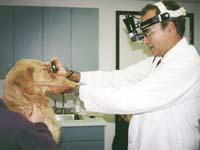
(Photo: University of Pennsylvania)
So, is there any reason to be optimistic?
Time will tell. Here you have to continue working.
Does it only serve for pigmentary retinosis? Can't it be used in similar diseases?
This technique is very precise and is specially designed to combat pigmentary retinosis. In the case of pigmentary retinosis there is a gene, RPE 65. This gene suffers a mutation, suffers a damage and produces a disease. Therefore, treatment is only valid for patients with this type of retinosis.
If you want to perform gene therapy in other similar diseases, you should first know the affected gene. In this way you could design a treatment that is said very fast and simple, but that actually requires a lot of time. Now we cannot catch the virus, modify it and create a new injection for the following week. All this requires a long, research-based process that ensures that the treatment is effective and will not cause any damage. After these studies and studies, treatments are received.
Although when we started to talk about gene therapy, messages of hope were generated, it seems that time has somewhat obscured the clear future being announced.
Gene therapy is and will be like any other therapy: it will have a very effective use in certain diseases, but not all. When we achieve good results, most of us heat up a lot... but the results of basic research cannot be achieved in the same way in clinical trials, sometimes it is impossible to approach. In the case of pigmentary retinosis, it is clear that the results obtained in basic research have been, in part, transferred to clinical trials due to the improvement of patients.
Long research, less satisfactory results in human... What could you say to that has the problem of retinosis?
To have a lot of patience and before anything you know exactly what disease you have. The whole of the retinosis is a set of many diseases, of which at least 190 genes are known. Of these, 145 are well known, but the number increases year after year. We have to make a genotype of the disease to know which genes, or which, have a defect, what are the mutations, and thus can be able to get an effective treatment in the not too distant future.
Gene therapy versus pigmentary retinosis
Elena Vecino / Professor of Cell Biology of the UPV
Pigmentary retinosis has long been one of the most unknown diseases of vision and when we begin to know it we have realized the complexity of it. The complexity derives from the diversity of mutations that can cause the disease and the progression of the disease forward. Therefore, it is impossible to know when it will be attacked in the most violent way.
One of the causes of the delay in the exhaustive knowledge of the disease, as it happens in other pathologies, has been the absence of animal models to investigate the origin of the disease and its mechanisms of advancement. The best models are, without a doubt, those in which the disease is born naturally. Thanks to veterinarians ophthalmologists it was discovered that dogs had disease.
(…)
For years, retinosis dogs have been investigated in depth, at molecular, cellular and ophthalmological levels, as well as their behavior until reaching the only therapies currently being tested against the retinosis. Thus, in the 1990s, with gene therapy and encapsulated cells, the first clinical trials with dogs were conducted. These trials gave very good results, so the FDA gave green light to the projects of clinical trials with humans.
At the origin of the therapies currently being developed in humans are the studies carried out by the team led by Dr. Gustavo Aguirre at the University of Pennsylvania with encapsulated cells and gene therapy. Currently, two anti-retinosis pigmentary therapies are being used in clinical trials with humans: the clinical trial that is being carried out by encapsulation of modified cells with the aim of releasing trophic factors (especially the CNTF factor). Phase 1, while the gene therapy used by adenoassociated viruses carrying the direct gene, encoder of the protein RPE65, is in phase I.
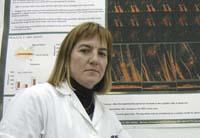
(Photo: UPV)
(...) If the results of these trials that began in England in May were satisfactory, we would be faced with the first effective therapy that arose a letter to deal with a specific mutation in the retina. This could have continuity with the treatment of other mutations and could also be used with other genes related to retinosis pigmentaria.
The gene therapy of the adenoassociated AAV viruses, which carry a gene that directs the mutation causing the disease, has opened the doors of an à la carte therapy for people with pigmentary retinosis "rare disease".
(…)
At this moment, undoubtedly, the challenge is to know the type of mutation that people suffering from the disease have, in order to complete the international map of those affected by the same mutation. (…)
After thirty years of research work, the therapy against retinosis is closer, but you have to advance with prudence, without going too fast. Waiting for the communication of what happens in the results of the first patients is fundamental to improve to the maximum before starting routine treatment.
Editorial at Arch Soc Esp Oftalmol 83 (2008), 213-214. Summary.
Kortabarria Olabarria, Beñardo
Services Services Services
250 250 250 250 250
2009 2009 2009 2009 2009
Services Services Services
033 033 033 033
Veterinary medicine Veterinaria Veterinaria
Article Article Article
Description Description Description Description













